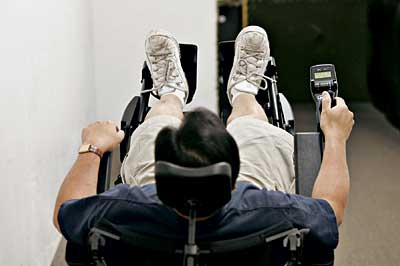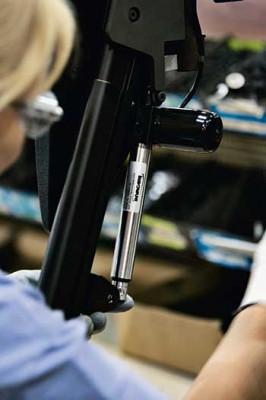A can-do attitude
Spurred by two men with a dream and a few dollars, US-based Invacare Corporation has become a global leader in the home health-care industry.
Summary
SKF is a major provider of actuation systems to Invacare, especially for use in wheelchair applications. And SKF’s maintenance-free CAT 21 linear actuator is an important element in Invacare’s new design for power legrests.The previous design, which had used an in-line actuator, suffered power and speed problems as well as many returns, says Invacare Product Engineering Manager Mark Cartellone. “We partnered together (with SKF) and got to it quickly, and basically took returns down to almost nothing.”When Invacare approached SKF about the binding and stiction problems, the CAT 21 series was already in development, says SKF Business Manager Alan Augello. The legrest application was actually a big factor in SKF manufacturing the series, he says.
Legrests are a vital component of what Invacare calls a tilt-recline system, which moves and tilts individuals who are immobilized from the waist or neck down. Because these wheelchair users have no leg movement, the power legrest helps to relieve pressures that are created by sitting for long periods of time and being constantly in certain positions.CAT 21 is a series of compact electromechanical linear actuators that enable movements such as pushing, pulling and lifting, especially in applications where there are space limitations. The modular and flexible design concept makes it easy to interchange critical components such as motors, screws and attachments. This enables easy, cost-effective customization for an infinite number of applications.
For Invacare’s legrest, the CAT 21 was somewhat customized, says Augello. Namely, the gear housing was anodized, and a special angle cross hole for the rear attachment was implemented.
Spurred by two men with a dream and a few dollars, US-based Invacare Corporation has become a global leader in the home health-care industry.
“It’s a very dynamic company,” says Mark Cartellone, product engineering manager, as he sums up Invacare and its corporate philosophy.
Invacare is not only the world’s largest wheelchair manufacturer, but it is also the largest global supplier of home health-care products. And the driving force for all of this is A Malachi (Mal) Mixon, III, Invacare’s chairman and chief executive officer, who led a leveraged buy-out of the company in 1979.
As the story goes, Mixon had a dream and 10,000 US dollars in savings. But the company was being sold for USD 7.8 million. Despite the seemingly insurmountable financial odds, Mixon, with the help of partner Joseph (JB) Richey, who serves as executive vice president, managed to borrow and raise the rest of the money through business loans and a group of local investors. The rest, as they say, is history.
When Mixon bought the company in late 1979, annual sales were USD 19 million. By 2003, after more than two decades under his stewardship and a string of key acquisitions, Invacare’s sales had risen to USD 1.25 billion. The company’s goal is to reach USD 2 billion in revenues by 2006. And Mixon’s “Yes, you can” philosophy has become a company mantra.
“So, two gentlemen and a little bit of money and a lot of heart and a lot of guts have done rather well and grown the business,” says Cartellone.
“Ninety percent of this is new product development,” he explains, pointing out that Invacare has replaced a staggering 90 percent of its product line in North America – in the past three years. Keep in mind, this is accomplished not by manufacturing mere replacements, but rather by creating entirely new products with improved performance. And the goal is to maintain this high level of turnover.
“Invacare supplies a very dynamic environment for engineers and for development. That’s what makes it an exciting place, and that’s why we’ve grown here,” he says. Cartellone works in rehabilitation engineering, where the focus is mainly on power wheelchairs for use in consumer and custom applications. His challenge is to render the company’s successes obsolete.
“We replace our products with brand new products, with features that other products don’t have,” he says. “And, obviously, we maintain competitive pricing against the competition.”
New technology, feedback from therapists and customer input are all a part of this process. For Cartellone and his colleagues, it means spending a certain amount of time in the field.
There’s a lot of customer input and feedback, typically at the beginning of projects. This means engaging in a lot of testing – in the field and in focus groups. Invacare also works hand-in-hand with clinics, physical therapists and other companies.
“We not only listen to consumer needs, we also look at what the therapist is asking for and looking for. We try to maintain a high level of contact there to improve the product,” Cartellone says.
Headquartered in Elyria, Ohio, just outside of Cleveland, Invacare conducts business in more than 80 countries and has the largest distribution network in the industry.
The company also offers the broadest line of home health-care products. This includes everything from canes, crutches, walkers and home-care beds to respiratory therapy devices, scooters and a full range of manual, custom manual and power wheelchairs.
“One of Invacare’s statements is ‘We have one-stop shopping here,’” says Cartellone. What this means for a typical supplier in the mobility or rehabilitation market is full-service shopping through one company.
Invacare has deep roots in the wheelchair business, tracing back to 1885, when the Worthington Company began making a line of vehicles designed for people with disabilities. Since then, the company has experienced a number of changes, as well as substantial growth in its product line. But throughout, wheelchairs have always remained a top priority.
In the US alone, each day Invacare manufactures hundreds of power wheelchairs. And, on the high end, it also builds chairs that are customized specifically for the needs of a particular user. These are typically full seating systems operated with electronics, such as the chair used by quadriplegic actor Christopher Reeve.
“It can be what we call ‘sip and puff’ or ‘head control’ for someone who doesn’t have any motion from the neck down,” Cartellone explains.
These innovative technologies enable quadriplegics to move their wheelchairs backwards and forwards, from side to side, and to control the speed – all on their own. This freedom of movement and independence is a significant benefit for users.
”The challenge is always to provide products that enhance the quality of life of the individual,” says Cartellone.
On April 19, 2004, Invacare-sponsored athletes swept the men’s and women’s wheelchair divisions and the women’s handcycling division at the Boston Marathon. Men’s winner Ernst Van Dyk smashed the course record, clocking a time of 1:18:27, nearly three minutes faster than the previous record. Just five months earlier, teammates Krige Schabort and Van Dyk finished first and second, respectively, in the New York City Marathon.
These individuals are among some 75 athletes and teams that make up “Team Invacare.” The athletes include some of the top competitors around the world in wheelchair racing, tennis, basketball, handcycling, and quad rugby. They exemplify the power of accomplishment and high quality of life. And they represent yet another extension of Invacare’s “Yes, you can” philosophy.







